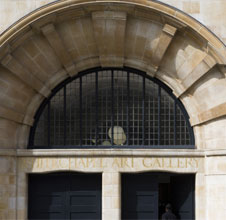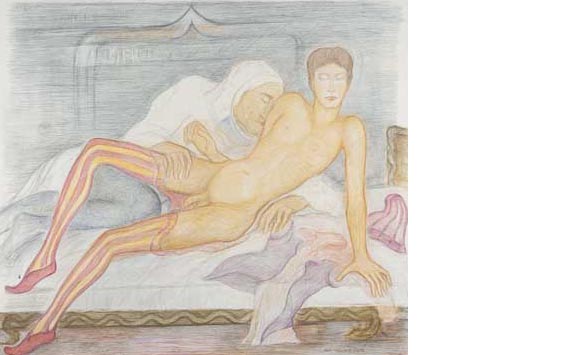Pierre Klossowski
20 September - 23 November 2006
Artist, philosopher, novelist and
translator, Pierre Klossowski created an intense world of violence,
passion, moral turbulence and theological inquest.
Born in Paris in 1905. Klossowski embarked on a writing career
through close relationships with Rainer Maria Rilke, André Gide and
Georges Bataille. Following the encouragement of André Masson, Alberto
Giacometti and his younger brother the painter Balthus, Klossowski
produced a number of drawings to illustrate his first novel, Roberte ce
soir, in 1953. A two-year eruption of drawing followed when Klossowski
produced numerous life-size portraits in lead pencil, attempting to
capture ‘the silvery, shimmering effect of the silent screen…’
His first public exhibition was held in Paris in 1967, a few years
before he applied colour in his drawings, to rediscover the ambience of
old theatre posters and trompe-l’oeil painting. Made with scholarly
application and minute, feathery strokes, recalling the self-imposed
discipline of a monastic miniaturist, Klossowski rejuvenated the ancient
subject of the nude. He rehearsed well-worn themes, obsessively
repeating sado-erotic scenes referring to a roll call of ‘spirits’ from
throughout the ages, whether mythological, historical, fictional,
mystical, folkloric or art historical. Among them Diana and Actaeon,
Tarquin and Lucretia, Ganymede and Klossowski’s own invention, Roberte,
centred around his wife and muse. They are supported by a large cast
ranging from Alexandre Dumas’ femme fatale Milady, the 15th century
serial killer Gilles de Rais and Jonathan Swift’s Gulliver.
Klossowski’s delicate balancing act between submission and
resistance weaves complex threads of theology, philosophy, pornography
and mythology. These themes echo through his drawings and written texts
and attracted the admiration of intellectuals including Gilles Deleuze
and Michel Foucault. Klossowski also worked with a number of filmmakers
from the 1970s onwards and produced three sculptures in the 1990s. From
his apartment in Paris, where he lived with his wife Denise, he
continued to inspire generation after generation until his death in
2001.
Curated by Sarah Wilson.
Admission free.






